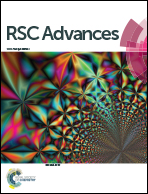Synthesis and characterization of ferric tannate as a novel porous adsorptive-catalyst for nitrogen removal from wastewater
Abstract
Ferric tannate has unique adsorption capacities for NH4+-N and NO2−-N simultaneously. So far, no normative method is available for synthesizing ferric tannate. In this work, an optimized method for synthesizing ferric tannate by using tannic acid and ferric chloride is established under the conditions of room temperature and neutral pH. The optimal molar ratio of tannic acid and ferric chloride were determined to be in the range of 1 : 20 to 1 : 25 based on the yield and stability of the ferric tannate composite. Scanning electron microscopy, the Brunauer–Emmett–Teller method, X-ray diffraction, and Fourier transform infrared spectrometry were used to characterize the ferric tannate composite. The results showed that the ferric tannate has a rough and porous surface, a large surface area, and an amorphous structure. Experiments of NH4+-N and NO2−-N adsorption reflected that the ferric tannate composite has a unique capacity for adsorption-catalyzed conversion of NH4+-N and NO2−-N to N2. When the mass ratios of ferric tannate/NH4+-N and ferric tannate/NO2−-N were both 200, the removal of NH4+-N and NO2−-N was 98.1% and 96.2%, respectively, after 3.0 hours of reaction. The conversion rate of N2 increased to 87.1%. Therefore, ferric tannate can be used as a potential material for removing nitrogen from wastewater in the future.


 Please wait while we load your content...
Please wait while we load your content...